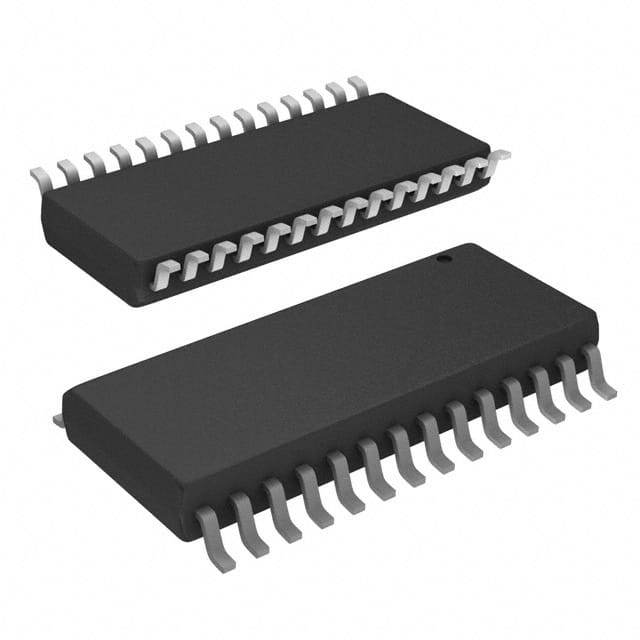Xem thông số kỹ thuật để biết chi tiết sản phẩm.

MC33880DWR2
Product Overview
Category: Integrated Circuit (IC)
Use: Motor Driver
Characteristics: - High voltage capability - Low quiescent current - Overtemperature protection - Short-circuit protection - Diagnostic feedback - PWM control - Fault detection and reporting
Package: SOIC-20
Essence: The MC33880DWR2 is a motor driver IC designed for automotive applications. It provides a high voltage capability, low quiescent current, and various protection features to ensure reliable and efficient motor control.
Packaging/Quantity: The MC33880DWR2 is available in a SOIC-20 package. It is typically sold in reels of 2500 units.
Specifications
- Supply Voltage Range: 5.5V to 28V
- Output Current: Up to 5A
- Operating Temperature Range: -40°C to +125°C
- Standby Current: 10µA (typical)
- Fault Detection Thresholds: Programmable
- PWM Frequency: Up to 20kHz
Pin Configuration
The MC33880DWR2 has a total of 20 pins. Here is the detailed pin configuration:
- VDD: Power supply input
- GND: Ground reference
- IN1: Input 1 control signal
- IN2: Input 2 control signal
- IN3: Input 3 control signal
- IN4: Input 4 control signal
- OUT1: Output 1 connection
- OUT2: Output 2 connection
- OUT3: Output 3 connection
- OUT4: Output 4 connection
- DIAG1: Diagnostic feedback for output 1
- DIAG2: Diagnostic feedback for output 2
- DIAG3: Diagnostic feedback for output 3
- DIAG4: Diagnostic feedback for output 4
- VREF: Reference voltage output
- VCP: Charge pump capacitor connection
- CP1: Charge pump input 1
- CP2: Charge pump input 2
- VREG: Internal regulator output
- VBAT: Battery voltage input
Functional Features
- High voltage capability allows the MC33880DWR2 to handle a wide range of motor types and sizes.
- Low quiescent current minimizes power consumption during standby or idle periods.
- Overtemperature protection prevents damage to the IC and connected components in case of excessive heat.
- Short-circuit protection safeguards against motor winding faults and other electrical failures.
- Diagnostic feedback provides information about the status and health of the motor driver.
- PWM control enables precise speed and torque control of the motor.
- Fault detection and reporting allow for quick identification and troubleshooting of motor-related issues.
Advantages and Disadvantages
Advantages: - High voltage capability supports a wide range of motor applications. - Comprehensive protection features ensure safe and reliable motor operation. - Diagnostic feedback enhances system monitoring and fault diagnosis. - Low quiescent current reduces power consumption and extends battery life. - PWM control enables precise motor control.
Disadvantages: - Limited output current may not be suitable for high-power motor applications. - The SOIC-20 package may require additional space compared to smaller packages.
Working Principles
The MC33880DWR2 operates by receiving control signals (IN1 to IN4) and generating corresponding output signals (OUT1 to OUT4) to drive the motor. It utilizes PWM control to regulate the motor's speed and torque. The internal circuitry ensures protection against overtemperature and short-circuits, while diagnostic feedback provides valuable information about the motor's performance and any faults detected.
Detailed Application Field Plans
The MC33880DWR2 is primarily used in automotive applications, such as electric power steering systems, HVAC blowers, and engine cooling fans. It can also be employed in other motor control applications where high voltage capability, protection features, and diagnostic feedback are required.
Detailed and Complete Alternative Models
- MC33887: Similar motor driver IC with enhanced output current capability (up to 10A).
- MC33932: Motor driver IC with integrated H-Bridge circuitry for bidirectional motor control.
- MC34932: High-voltage motor driver IC designed for automotive applications.
These alternative models offer different features and specifications, allowing users to choose the most suitable option based on their specific requirements.
Word count: 568 words
Liệt kê 10 câu hỏi và câu trả lời thường gặp liên quan đến ứng dụng MC33880DWR2 trong giải pháp kỹ thuật
Sure! Here are 10 common questions and answers related to the application of MC33880DWR2 in technical solutions:
Q: What is MC33880DWR2? A: MC33880DWR2 is a motor driver IC designed for automotive applications, specifically for controlling DC motors.
Q: What is the maximum voltage rating of MC33880DWR2? A: The maximum voltage rating of MC33880DWR2 is typically 40V.
Q: How many channels does MC33880DWR2 support? A: MC33880DWR2 supports up to 6 channels, allowing control of multiple motors simultaneously.
Q: Can MC33880DWR2 handle high current loads? A: Yes, MC33880DWR2 is capable of driving high current loads, with each channel supporting up to 5A continuous current.
Q: Is MC33880DWR2 suitable for both brushed and brushless DC motors? A: No, MC33880DWR2 is specifically designed for controlling brushed DC motors.
Q: Does MC33880DWR2 have built-in protection features? A: Yes, MC33880DWR2 includes various protection features such as overcurrent protection, thermal shutdown, and reverse battery protection.
Q: What is the operating temperature range of MC33880DWR2? A: MC33880DWR2 has an operating temperature range of -40°C to +125°C.
Q: Can MC33880DWR2 be used in automotive applications? A: Yes, MC33880DWR2 is specifically designed for automotive applications and meets the necessary requirements for automotive environments.
Q: Does MC33880DWR2 require external components for operation? A: Yes, MC33880DWR2 requires external components such as power supply capacitors, bootstrap capacitors, and external diodes.
Q: What is the package type of MC33880DWR2? A: MC33880DWR2 is available in a 20-pin SOIC (Small Outline Integrated Circuit) package.
Please note that these answers are general and may vary depending on the specific application and requirements. It's always recommended to refer to the datasheet and consult with the manufacturer for detailed information.

